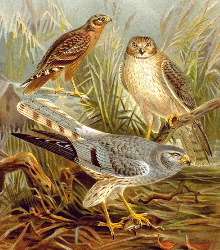Harrier (bird)
| Harriers | |
|---|---|
 | |
| Montagu's harrier | |
| Scientific classification | |
| Kingdom: | Animalia |
| Phylum: | Chordata |
| Class: | Aves |
| Order: | Accipitriformes |
| Family: | Accipitridae |
| Subfamily: | Circinae |
| Genera | |
|
Circus | |
A harrier is any of the several species of diurnal hawks forming the Circinae sub-family of the Accipitridae family of birds of prey. Harriers characteristically hunt by flying low over open ground, feeding on small mammals, reptiles, or birds. The young of the species are sometimes referred to as ring-tail harriers.
Etymology
The genus Circus was introduced by the French naturalist Bernard Germain de Lacépède in 1799.[1][2] Most harriers are placed in this genus. The word Circus is derived from the Ancient Greek kirkos, referring to a bird of prey named for its circling flight (kirkos, "circle"), probably the hen harrier.[3]
Two other harriers are in the genus Polyboroides, the harrier-hawks, which are allopatric (geographically separated) and restricted to the Afrotropic ecozone. The remaining single species forms the monotypic genus Geranospiza.
Ring-tails
Ring-tail is an informal term used by birders for the juveniles and females of several harrier species when seen in the field and not identifiable to an exact species. Ring-tail harriers include the juveniles and females of Montagu's harrier (Circus pygargus); northern or hen harrier (Circus cyaneus); and pallid harrier (Circus macrourus).
Species
- Genus Circus
- Montagu's harrier, Circus pygargus – Eurasia, winters in Africa and India
- Hen harrier, Circus cyaneus – Eurasia and North America
- Western marsh harrier, Circus aeruginosus – Europe, western Asia; winter range includes Africa and India.
- Eastern marsh harrier, Circus spilonotus – Asia (migratory)
- Papuan harrier, Circus spilothorax – New Guinea (formerly in C.spilonotus)
- African marsh harrier, Circus ranivorus – southern and central Africa
- Swamp harrier, Circus approximans – New Zealand, Australia, Pacific islands
- Malagasy harrier, Circus macrosceles (formerly in C. maillardi) – Indian Ocean (Madagascar and the Comoro Islands)
- Réunion harrier, Circus maillardi – (Indian Ocean) Réunion Island
- Long-winged harrier, Circus buffoni – South America
- Spotted harrier, Circus assimilis – Australia, Indonesia
- Black harrier, Circus maurus – southern Africa
- Cinereous harrier, Circus cinereus – South America
- Pallid harrier, Circus macrourus – migratory: eastern Europe, Asia, Africa (winter)
- Pied harrier, Circus melanoleucos – Asia
- Eyles' harrier, Circus eylesi (prehistoric)
- Wood harrier, Circus dossenus (prehistoric)
BirdLife International recognises an additional species the northern harrier (Circus hudsonius) normally considered a subspecies of the hen harrier[4]
- Genus Polyboroides
- Madagascan harrier-hawk, Polyboroides radiatus
- African harrier-hawk, Polyboroides typus
- Genus Geranospiza
- Crane hawk, Geranospiza caerulescens
Notes
- ↑ Lacépède, Bernard Germain de (1799). "Tableau des sous-classes, divisions, sous-division, ordres et genres des oiseux". Discours d'ouverture et de clôture du cours d'histoire naturelle (in French). Paris: Plassan. p. 4. Page numbering starts at one for each of the three sections.
- ↑ Mayr, Ernst; Cottrell, G. William, eds. (1979). Check-list of Birds of the World. Volume 1 (2nd ed.). Cambridge, Massachusetts: Museum of Comparative Zoology. p. 316.
- ↑ Jobling, James A. (2010). The Helm Dictionary of Scientific Bird Names. London: Christopher Helm. p. 109. ISBN 978-1-4081-2501-4.
- ↑ "Northern Harrier (Circus hudsonius) - BirdLife species factsheet".
External links
- Harrier videos on the Internet Bird Collection
- Harrier videos on the Internet Bird Collection